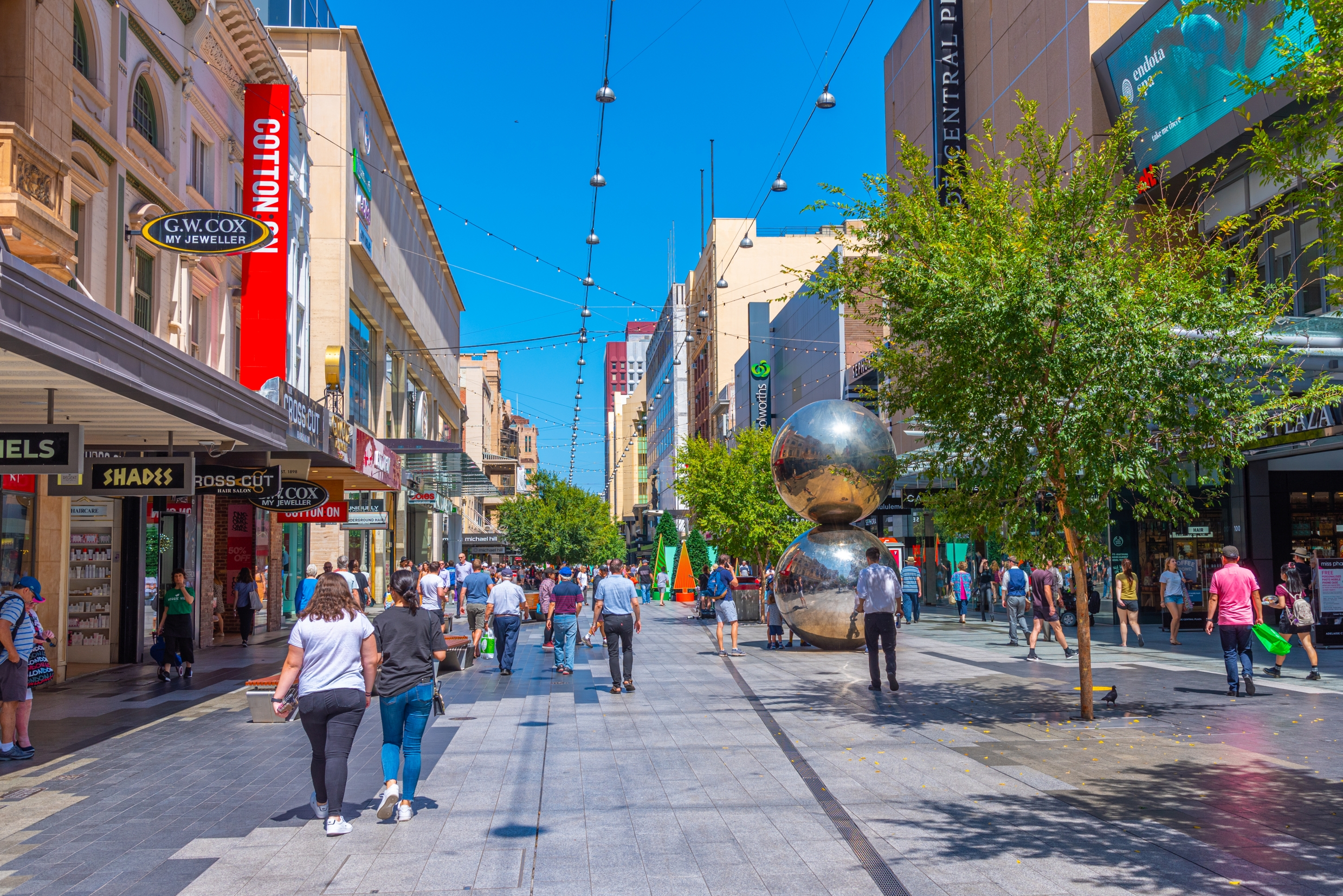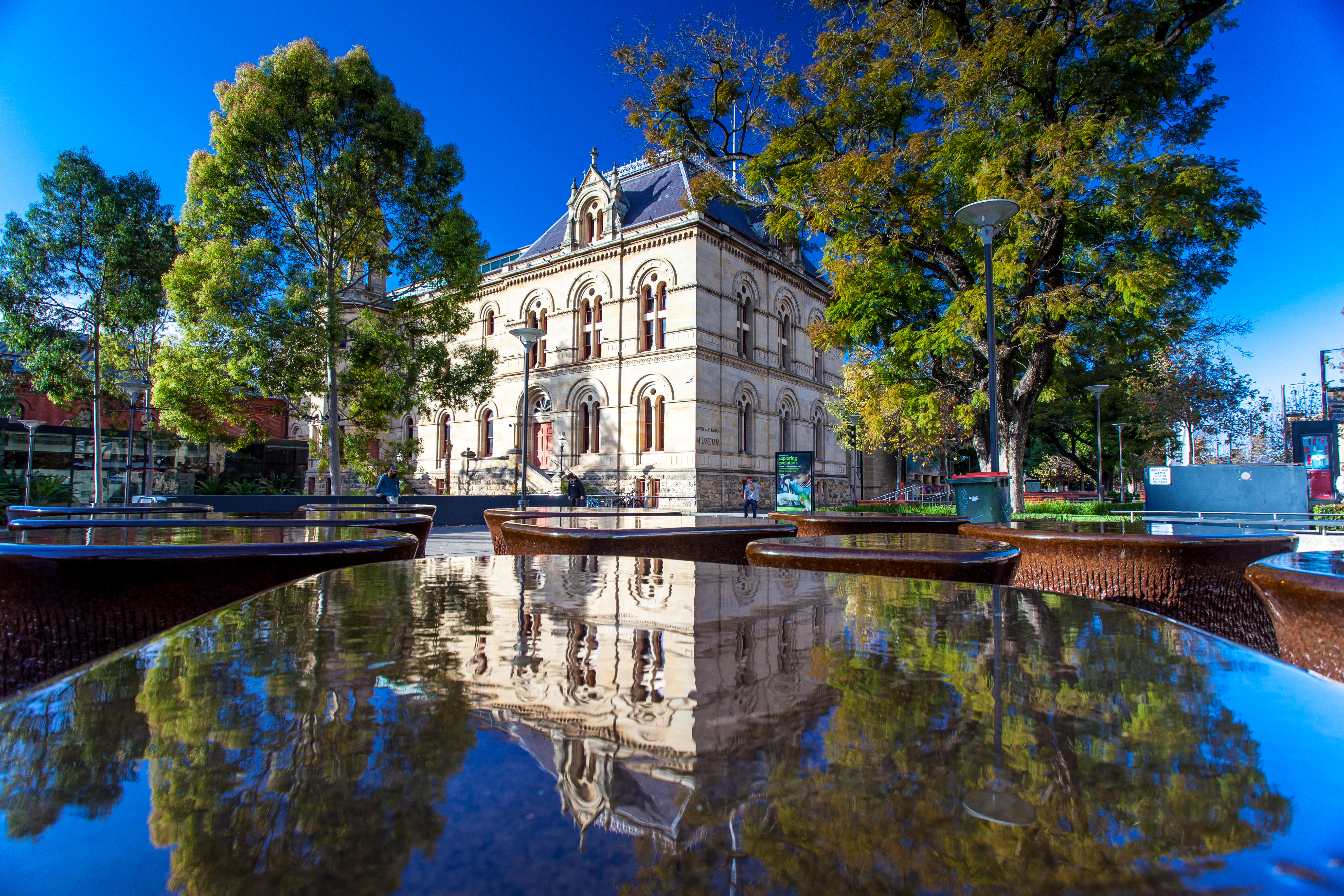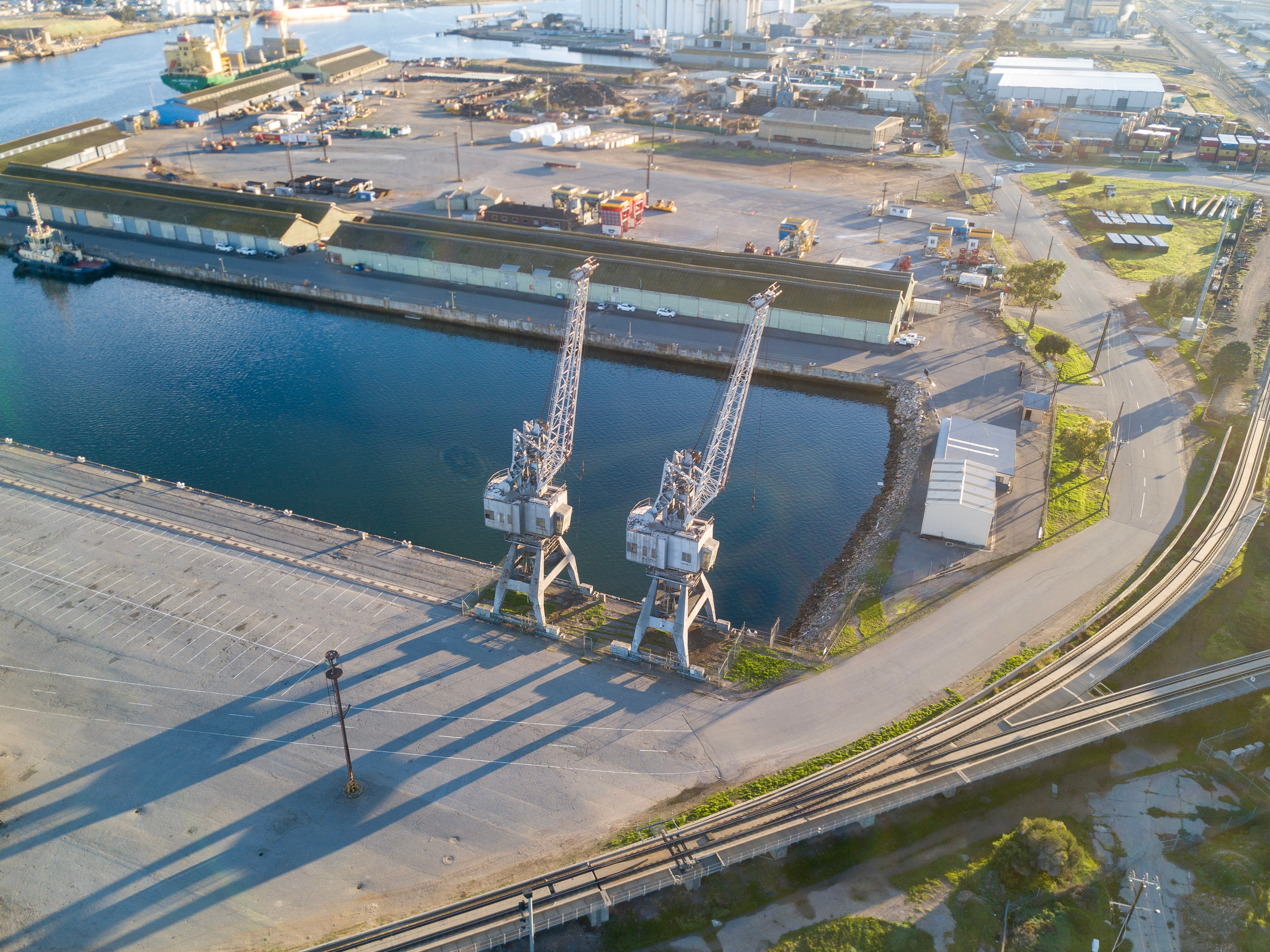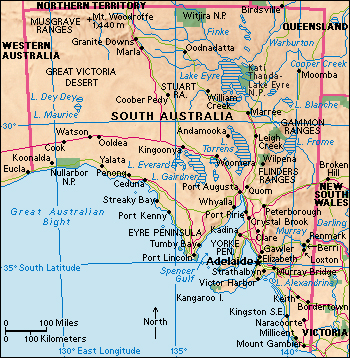Adelaide << AD uh `LAYD` >> (pop. 1,245,011; met. area pop. 1,387,290) is the capital and chief port of the state of South Australia. The city was named after Queen Adelaide, the wife of the British monarch William IV. Adelaide is South Australia’s most important administrative, commercial, cultural, and industrial center. It is also the state’s main transport hub, and an important collection and distribution point for manufactured goods. Adelaide’s abundant parklands, nearness to the beautiful Adelaide Hills, and picturesque, sandy beaches make it popular with visitors. The city attracts large numbers of tourists from Asia, Europe, New Zealand, and the United States.

Adelaide lies on a coastal plain between Gulf St. Vincent, to the west, and the Adelaide Hills, which are part of the south Mount Lofty Ranges. The metropolitan area consists of the City of Adelaide and a number of suburbs. It covers about 700 square miles (1,800 square kilometers). At the center of the metropolitan area is the city’s main business district, a planned, gridlike area of about 1 square mile (2.6 square kilometers) surrounded by parklands.
Adelaide has a pleasant climate with warm, dry summers and cool, moist winters. Annual rainfall averages about 21 inches (53 centimeters), making Adelaide Australia‘s driest capital city.
The City of Adelaide,
designed by Surveyor General William Light in the 1830’s, lies north and south of the Torrens River. The main downtown area is south of the river. It consists primarily of wide, tree-lined streets and squares arranged in a grid. Four grand boulevards—North Terrace, South Terrace, East Terrace, and West Terrace—frame this grid. Beyond these boulevards is a wide border of parklands and recreation grounds. The Torrens River flows through the parklands to the north of the downtown area, serving as a dividing line between downtown Adelaide and North Adelaide, also surrounded by parklands.
The central grid is the heart of the business, political, and social life of Adelaide. It includes many grand old Victorian and Edwardian buildings, alongside more modern structures. Rundle Mall, a pedestrian mall, is the center of Adelaide’s main shopping area. Nearby North Terrace is the site of art galleries, museums, and such historic structures as Government House, Parliament House, the South Australian National War Memorial, and Adelaide Railway Station, which now houses both a railway station and a casino. North Terrace is also home to the University of Adelaide and the State Library of South Australia.


Adelaide’s older industrial and residential areas lie beyond the parklands that surround the city center. Glenelg, for example, is a beachfront suburb connected to the city center by Adelaide’s one remaining tramway. With boutiques, cafes, and restaurants overlooking the sandy beach, Glenelg is a popular spot for both residents and visitors. Beyond the older suburbs lie sprawling new suburbs that extend north and south along the coastline and northeast into the Adelaide Hills.
Most of Adelaide’s buildings are made of brick or stone. The first colonists built their houses of brick, limestone, and compressed earth. The first governor’s residence was constructed with clay and wood. During the late 1800’s and early 1900’s, builders erected many beautiful blue stone buildings, including some fine churches. Adelaide is sometimes called the City of Churches because it has so many beautiful houses of worship.
One of Adelaide’s grandest stone buildings is Parliament House, home to the state Parliament since 1889. Another is Ayers House, a gracious mansion completed in 1855 for Henry Ayers, who later became premier of South Australia. Other fine buildings include the Roman Catholic Cathedral of St. Francis Xavier, begun in 1854 and completed in 1996; the Supreme Court, opened in 1866; and St. Peter’s Anglican Cathedral, begun in 1869 and completed in 1904.
People.
About 70 percent of South Australians live in Adelaide. Since the end of World War II in 1945, large-scale immigration has increased the state’s ethnic diversity. Most immigrants to South Australia have settled in Adelaide. People from the United Kingdom are by far the largest immigrant community in Adelaide, accounting for about 5 percent of the population. Many people have also come from China, India, Italy, and Vietnam.
Education.
The state provides free primary and secondary education in Adelaide. There is also a wide choice of private schools run by church and independent organizations.
Most of the state’s postsecondary educational institutions are in Adelaide. They include the University of Adelaide, established in 1874; Flinders University, opened in 1966; and the University of South Australia, formed in 1991. Several Technical and Further Education (TAFE) colleges around Adelaide provide adult and vocational education. Adelaide’s educational institutions attract many overseas students, primarily from Asian countries.
Cultural life.
Adelaide is a lively cultural center. It is home to several arts and music festivals. The most important of these events is the Adelaide Festival of Arts, held every two years in late February and early March. It provides a showcase for Australian creative and performing artists and attracts well-known international performers. The annual Adelaide Fringe festival also provides entertainment, much of which is free. WOMADelaide takes place in Adelaide’s Botanic Park for three days in March. WOMAD stands for World of Music and Dance. Come Out is one of the largest and longest-running youth art festivals in the world.
The Adelaide Festival Centre, on the banks of the Torrens River, is home to the Adelaide Festival of Arts. The center also hosts ballets, concerts, operas, plays, and major art exhibitions. Constructed in the 1970’s, the buildings that make up the center have large, white, sail-like roofs.
The Art Gallery of South Australia is Adelaide’s largest and most important gallery. It has a sizable collection of Australian and South Australian art of the 1800’s and 1900’s. The South Australian Museum houses one of the world’s largest collections of items that represent the cultures of Aboriginal peoples of Australia and the peoples of the southwestern Pacific and New Guinea. Other museums include the Tandanya National Aboriginal Cultural Institute, the Migration Museum, and the South Australian Maritime Museum at Port Adelaide. 
Recreation.
Parklands and recreation grounds encircle Adelaide city center. The Botanic Garden, which opened in 1857, features the Palm House, one of the oldest greenhouses in Australia. Adelaide Zoo, which opened in 1883, is the second oldest zoo in the country. Only Melbourne Zoo, which dates from 1862, is older.
Other recreational facilities include the Victoria Park Racecourse, the Memorial Drive tennis complex, and the Adelaide Oval, which hosts cricket and Australian Rules football games. The AAMI Stadium (formerly Football Park), in the northern suburb of West Lakes, also hosts Australian Rules football. North Adelaide is home to one of Australia’s largest indoor aquatic centers. The Super-Drome is the headquarters of the Australian Institute of Sport’s Track Cycling Program.
Economy.
About three-quarters of South Australia’s labor force works in the Adelaide area. Manufacturing is a major economic activity in the metropolitan area. Products include machinery, motor vehicles, electrical goods, and processed foods.
Adelaide also has a significant defense industry. During the 1990’s, it became a base for the design, construction, and maintenance of Royal Australian Navy submarines. The Defense Science and Technology Organisation, which is part of the Australian Department of Defense, has laboratories in the suburb of Salisbury.
Business, education, health services, and tourism services are growing sources of employment and revenue. Adelaide is also the administrative base for many South Australian mining companies and serves as an administrative and promotional center for South Australia’s wine industry. Port Adelaide also supports a fishing industry.
Adelaide Metro oversees public bus, train, and tram services in metropolitan Adelaide. Adelaide Airport, Parafield Airport, and an airstrip at the Royal Australian Air Force Base Edinburgh are all within 16 miles (25 kilometers) of the city. Adelaide Airport is the city’s main airport, and Parafield serves lighter aircraft. Roads and railways connect Adelaide with Alice Springs, Darwin, Melbourne, Perth, and Sydney. Port Adelaide, north of the city center, is South Australia’s main port. Adelaide’s two main newspapers are the daily Advertiser and the weekly Sunday Mail. 
Government.
The Adelaide City Council governs the City of Adelaide. It consists of a lord mayor, five area councillors, and six ward councillors. They are all elected to three-year terms. The Capital City Committee coordinates state and local government activities to promote city development. This committee consists of the state premier, two state ministers, the lord mayor, and two local councillors. Local governing councils administer suburbs outside of the city.
History.
Aboriginal peoples were the first inhabitants of South Australia. The Kaurna people are the Aboriginal people of what is now Adelaide and the surrounding Adelaide Plains. The Kaurna name for the Adelaide area is Tarntanya (also spelled Tarndanya). European colonization in the area began in the 1800’s. Colonel William Light, the first surveyor general of South Australia, chose the site for Adelaide. He arrived at Kangaroo Island, off the coast of South Australia, in August 1836. After exploring Gulf St. Vincent, Light selected a location about 6 miles (10 kilometers) inland from Holdfast Bay. John Hindmarsh, South Australia’s first governor, arrived at Holdfast Bay on Dec. 28, 1836, and proclaimed the area a British colony. Unlike many early British settlers in other parts of Australia, Adelaide’s settlers were not convicts. They were free immigrants, many of whom sought religious and civil liberties. By the end of 1837, Adelaide had a population of about 2,500.

Port Adelaide was proclaimed a legal port on May 25, 1837. In August 1840, Governor George Gawler of South Australia passed the Municipal Council Act, which established Australia’s first municipal council. This governing council was a failure and stopped meeting in 1843. The South Australian government controlled the city until 1852, when the council was reestablished.
By the early 1840’s, such satellite villages as Bowden, Goodwood, Hindmarsh, Port Adelaide, Thebarton, and Walkerville had sprung up near Adelaide. Governor Gawler arranged for the construction of a customs house and a hospital, government offices, and roads. He also established a police force. The colony suffered a period of economic bankruptcy in the 1840’s. The discovery of copper where the towns of Burra and Kapunda now stand helped bring renewed prosperity. The suburbs of Kensington and Norwood became part of a separate municipality with its own governing council in 1853, as did Glenelg in 1855. By 1856, Adelaide’s population had reached more than 30,000.
From the 1850’s through the 1880’s, Adelaide’s communication and transportation systems had improved considerably. Electric telegraph service connected Adelaide with Melbourne in the 1850’s. In 1872, a telegraph line to Darwin was completed. This line also linked Adelaide to London via an underwater cable from Darwin to Java, plus additional lines extending across Asia and Europe. Adelaide and Perth were linked by telegraph in 1877. Adelaide’s first telephone exchange opened in 1883.
In 1856, a bridge connected King William Street in downtown Adelaide with North Adelaide, north of the Torrens River. By 1860, railway lines had been laid between Adelaide and the towns of Kapunda, Port Adelaide, and Salisbury. Beginning in 1878, a system of horse-drawn trams served the city and its suburbs. In 1887, the first train ran between Adelaide and Melbourne. In 1909, electric trams replaced the horse-drawn ones.
Adelaide experienced steady growth in the late 1800’s. A deepwater port opened in 1908 at Adelaide’s Outer Harbour (later spelled Outer Harbor). In 1925, the Metropolitan Tramways Trust introduced motor bus service in Adelaide. In 1937, the trust introduced electric trolley buses.
The Great Depression of the 1930’s brought economic hardship to the people of Adelaide. The South Australian Housing Trust, established in 1936, provided low-rent housing in suburban areas. During World War II (1939-1945), ammunition works opened at nearby Finsbury, Hendon, and Penfield. Industry continued to expand following the war.
In the 1980’s, the population of the metropolitan area passed the 1-million mark. To accommodate this growth, developers built new housing and shopping areas in such suburbs as Golden Grove, north of the city, and Noarlunga, to the south. In 2003, workers completed a north-south transcontinental railway that links Adelaide with Darwin in the Northern Territory. Trains began using the route in 2004. Adelaide’s major areas of economic growth in the 2000’s have included financial, health care, public administration, and technical services.
